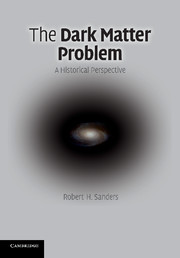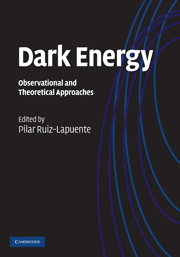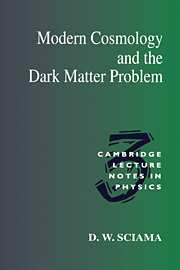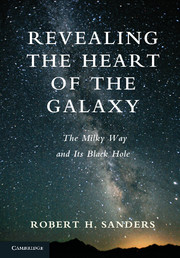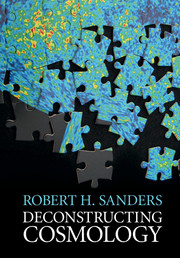The Dark Matter Problem
Most astronomers and physicists now believe that the matter content of the Universe is dominated by dark matter: hypothetical particles which interact with normal matter primarily through the force of gravity. Though invisible to current direct detection methods, dark matter can explain a variety of astronomical observations. This book describes how this theory has developed over the past 75 years, and why it is now a central feature of extragalactic astronomy and cosmology. Current attempts to directly detect dark matter locally are discussed, together with the implications for particle physics. The author comments on the sociology of these developments, demonstrating how and why scientists work and interact. Modified Newtonian Dynamics (MOND), the leading alternative to this theory, is also presented. This fascinating overview will interest cosmologists, astronomers and particle physicists. Mathematics is kept to a minimum, so the book can be understood by non-specialists.
- Discusses current attempts to directly detect dark matter locally, and the implications for particle physics
- Comments on the sociology of developments, demonstrating how and why scientists work and interact
- Presents Modified Newtonian Dynamics (MOND) - the leading alternative to the theory
Reviews & endorsements
"One of the most perplexing problems in astrophysics is the nature of the major component of the universe: dark matter. Author Sanders has been a major researcher in attempts to understand it. In this historical account, the presence of dark matter is traced from its discovery in 1933, through its rediscovery by optical and radio astronomers who investigated the rotation curves of galaxies and the internal motions of clusters of galaxies. They then traced light and mass as a function of galactic radius. Remarkable insight came with the discovery of hot gas in galaxies, satellites that explored details of the cosmic microwave background and the realization that a second problem existed: dark energy. Particle astrophysics and cosmology enter the picture and a realization that modified Newtonian dynamics may have to be invoked to explain phenomena that we cannot directly observe. This is a fascinating detective story, described in a personal and very readable way without much mathematics but presenting arguments that might be hard to follow without some background in physics. The appendix presents a beautiful summary of relevant definitions of astronomy. Black and white photos, graphs and drawings accompany the text. There are 6 pages of references and a 4-page index."
Bill Howard, CHOICE Magazine
This is a splendid and timely book and the reader is rewarded with an insight into the tantalising conflict between the majority proponent view of dark matter and the competing viewpoint embodied in the Modified Newtonian Dynamics (MOND) hypothesis... Sanders deals in detail with the astrophysical evidence which forms the basis of the dark matter viewpoint and contrasts its successes and shortcomings with the similarly limited success of MOND. The conflict is illustrated beautifully with a detailed account of the successful interpretation of flat galactic rotation curves by both proposals but Sanders also takes time to examine the key role played by the demands of spiral galaxy stability, by studies of Low Surface Brightness Galaxies and by the unique success of MOND in providing a possible basis for the Tully-Fisher Law. What was not available to Krauss in "The Fifth Essence" is the mass of information gleaned over the past twenty years by satellite based x-ray and microwave instrumentation, by high spacial resolution radio astronomy and through gravitational lensing analyses. … His book is written with the scientific community in mind and the language is uncompromisingly scientific but it is nonetheless fathomable by the non-specialist. Mathematical argument is kept to a minimum but is perhaps inevitable in discussing MOND - and there is a useful appendix which goes some way to provide a summarised background on which an inexpert reader can base a first reading. "The Dark Matter Problem" will find an easily accessible place on this reviewer's bookshelf for some time."
Brian Parsons, FAS Newsletter, Summer 2010
"La cosmologie est-elle en crise? Question apparemment incongrue au regard de l'actuelle prétention des cosmologistes d'avoir percé les secrets du cosmos. Cela dit, en science, on ne reconnaît bien souvent une crise qu'après coup. Y aurait-il donc des signes d'une possible remise en cause de la conception dominante de l'univers? Disons-le tout net: oui. Par exemple, dans l'actuelle théorie du big bang, 95% de l'énergie et de la matière de l'univers manque à l'appel. Pour retomber sur leurs pieds, les cosmologistes ont en effet été obligés de postuler l'existence d'une matière et d'une énergie de nature inconnue constituant la quasi-totalité de l'univers, tout en reconnaissant être incapables d'en détecter directement la moindre trace. C'est ce qu'on appelle le problème de la matière noire "The Dark Matter Problem", qui est présenté dans ce livre suivant une approche historique. Ce problème sera-t-il résolu sans bouleversement majeur de la physique ou de la cosmologie? Pour l'instant, il n'est bien sûr pas possible de répondre à une telle question. Mais il est très instructif de suivre les errements de la recherche en ce domaine. La matière noire, c'est effectivement l'arlésienne de la cosmologie. On en parle beaucoup depuis 40 ans; on est convaincu de son existence; mais on ne l'a jamais détectée directement. L'astronome Fritz Zwicky fut le premier à montrer dans les années 1930 qu'il manquait de la matière dans les amas de galaxies. Ne sachant pas trop quoi en penser, les astrophysiciens prêtèrent peu attention à cette anomalie. Mais elle refit surface dans les années 1970 quand on s'aperçut que les galaxies tournaient plus vite qu'elles auraient dû, à en juger par la masse de leur matière visible. Jusque là, rien de vraiment dramatique. Pourquoi faudrait-il que toute la matière soit visible? Le problème allait toutefois se corser. Toujours dans ces années 1970, la théorie du big bang assoit son hégémonie. Or s'il existe autant de matière que le suggère la dynami
"... readable and enjoyable book... On the whole, The Dark Matter Problem will benefit advanced undergraduates, graduate students, and some researchers. Students and professionals in the field may receive this book as a training tool that highlights the current deficiencies of the dark-matter paradigm. Understanding those deficiencies is an important part of the learning process."
Liliya L. R. Williams, Physics Today
Product details
February 2014Paperback
9781107677180
214 pages
244 × 170 × 11 mm
0.35kg
Available
Table of Contents
- 1. Introduction
- 2. Early history of the dark matter hypothesis
- 3. The stability of disk galaxies: the dark halo solutions
- 4. Direct evidence: extended rotation curves of spiral galaxies
- 5. The maximum disk: light traces mass
- 6. Cosmology and the birth of astroparticle physics
- 7. Clusters revisited: missing mass found
- 8. CDM confronts galaxy rotation curves
- 9. The new cosmology: dark matter is not enough
- 10. An alternative to dark matter: Modified Newtonian Dynamics
- 11. Seeing dark matter: the theory and practice of detection
- 12. Reflections: a personal point of view
- Appendix
- References
- Index.

